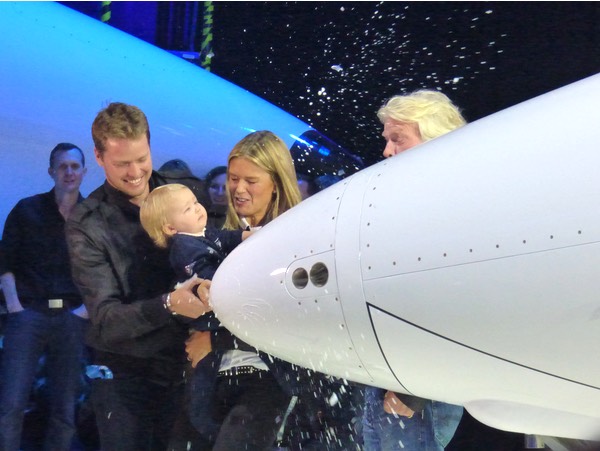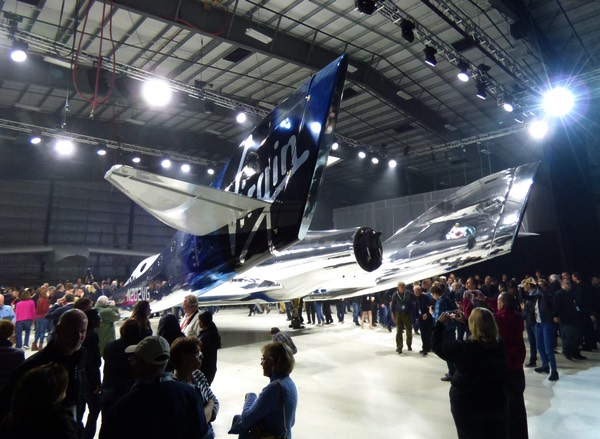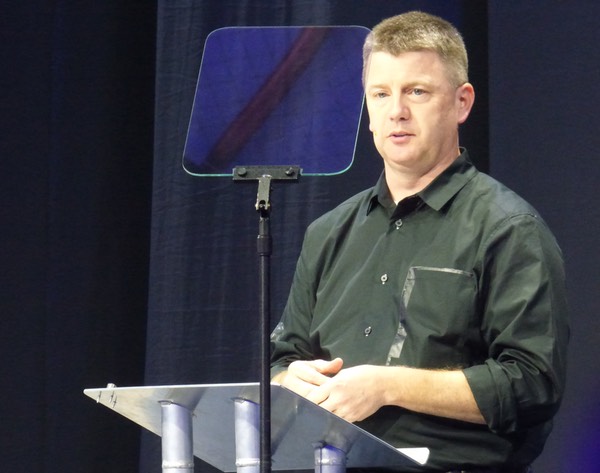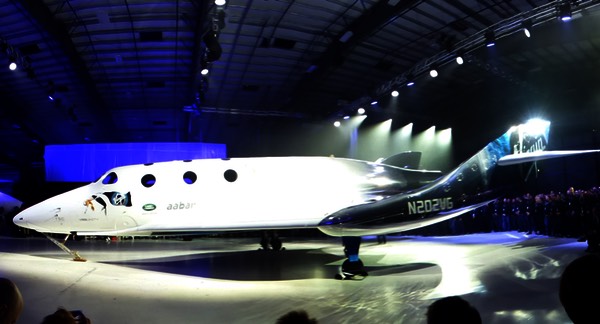Relaunching a spaceshipby Jeff Foust
|
| “I’ve always believed that having the best looking planes and trains in the world, while not a guarantee of success, is a good start,” Branson said. “But our new spaceship has taken that concept to a whole new level.” |
The daughter of Richard Branson’s son Sam became a part of the ceremonies at the Mojave Air and Space Port in California last Friday, where Branson’s Virgin Galactic unveiled the second SpaceShipTwo suborbital spaceplane. That rollout was, in many respects, a symbolic event to demonstrate the company’s recovery from the loss of the first SpaceShipTwo in a test flight accident in October 2014.
There was, as you might expect from any event involving the Virgin family of companies, a certain flair to Friday’s rollout. The company didn’t simply open a door or raise a curtain to unveil the spacecraft. It opened a curtain separating one part of the hangar, where the guests were assembled, from the other, where SpaceShipTwo was. A Range Rover, with Richard Branson standing in the sunroof, then towed SpaceShipTwo over to the audience. (The event was thus less of a “rollout” than a “rollover” as the vehicle never left the hangar.)
“All of us in this room need to pinch ourselves,” he said at the podium after the vehicle was in place in the other side of the hangar, now surrounded by the audience. “I’ve always believed that having the best looking planes and trains in the world, while not a guarantee of success, is a good start. But our new spaceship has taken that concept to a whole new level.”
Virgin had invited Stephen Hawking to the rollout if his health allowed him to make the trip. It apparently did not, so Branson instead played an audio message from the famous physicist, who is still interested in flying to space on SpaceShipTwo. “If I am able to go, and if Richard will still take me, I would be very proud to fly on this spaceship,” he said.
Hawking was given the honor of naming this new SpaceShipTwo. “We are entering a new space age, and I hope this will help to create a new unity. Space exploration has already been a great unifier,” he said, foreshadowing the name. “Please welcome Virgin Space Ship Unity.”
Then it was time to christen the new spaceship. The first SpaceShipTwo, VSS Enterprise, was christened in 2009 by two governors, Bill Richardson of New Mexico and Arnold Schwarzenegger of California. Its carrier airplane, WhiteKnightTwo, was christened in 2008 by Branson’s mother, Eve. This time Branson decided to keep the christening in the family, but went younger.
“I’m pretty sure a one-year-old has never christened a spaceship before, so we really are in virgin territory,” Branson quipped. That, though, required a change in spirit for the christening. “Clearly, champagne would be inappropriate, although it didn’t do me any harm,” he said. So, instead, Eva Deia christened the new spaceship with a bottle of milk, guided to the nose of the VSS Unity with the help of her parents.
If that wasn’t enough, Branson brought out another celebrity and Virgin Galactic customer to lead the audience in singing “Happy Birthday” for Eva Deia: singer Sarah Brightman.
 Richard Branson’s granddaughter, Eva Deia, christens the new SpaceShipTwo with a little help from her parents. (credit: J. Foust) |
“The same fundamental design”
Beyond the glitz and glamour of the event (including celebrity sightings like actor and pilot Harrison Ford, who got to go inside SpaceShipTwo with Virgin Galactic’s chief pilot, David Mackay), was SpaceShipTwo itself. The event marked a transition for the vehicle, which had been under construction by Virgin’s subsidiary, The Spaceship Company, since well before the 2014 accident.
| “If I had to sum it up, I would tell you [SpaceShipTwo] number two is a lot like number one,” Moses said. “It’s the same fundamental design.” |
“All of us here today have eagerly, very eagerly, anticipating the rollout of this spaceship, and that’s because it marks the very dramatic change for us as the employees,” said Mike Moses, senior vice president for operations at Virgin Galactic. “We go from the build phase, where we were planning and assembling and analyzing what will be, to the flightline phase, where it is living and breathing and performing what it is we all dreamt about.”
At first glance, the second SpaceShipTwo looks a lot like the first. There are a few minor differences visible, like larger horizontal stabilizers on the twin tail booms, as well as a new paint scheme that transitions from white on the fuselage to silver, with a large Virgin Galactic logo, on the booms.
There are additional, but less visible, changes elsewhere to the vehicle. In a briefing prior to the rollout, Moses said part of that came from lessons learned during the manufacturing of the first SpaceShipTwo by Scaled Composites. “It’s an evolutionary change,” he said. “When Scaled built the first one, they built it and they started testing, and they realized they wanted to do a few things differently. So we were able to incorporate those changes upfront.”
Examples of such changes he gave included tweaks to the outer mold line of the vehicle’s wings made during testing of the first SpaceShipOne, and rerouting of electrical cables inside the vehicle. “There’s nothing really sexy or exciting about those changes, it’s just the evolution of the design,” Moses said.
Then there are changes to SpaceShipTwo as a result of the accident and resulting investigation. “We did what I think every high risk, high profile, high reliability organization needs to do: used the lens of that accident to look at everything else that we do,” he said. “We looked at systems way beyond the scope of what the accident investigation asked us to look at, and we made a handful of little changes.”
That includes changes to address the specific, technical root cause of the accident, the premature unlocking of the vehicle’s feathering system. “We’re going to put a control system in place that prevents that handle from being moved if you’re in a regime where it’s not safe to move it,” Moses said. “There is literally now going to be a mechanical pin that prevents that lever from moving if the computer tells you it’s not a safe regime to do so.”
“If I had to sum it up, I would tell you [SpaceShipTwo] number two is a lot like number one,” Moses concluded. “It’s the same fundamental design. We didn’t find any fundamentals that were wrong or flawed.”
 Guests examine SpaceShipTwo from all the angles, including the vehicle’s tail section, after the rollout. (credit: J. Foust) |
A rocket motor that works
What wasn’t discussed at the rollout was SpaceShipTwo’s hybrid rocket engine, which had caused many of the development delays in the overall program, including a 2007 test stand accident that killed three Scaled employees. The engine’s design, and even its fuel, have changed over the years: the October 2014 flight was the first to use a nylon-like fuel, as opposed to the rubber-based hydroxyl-terminated polybutadiene (HTPB) previously used.
The engine was cleared of any role in the test flight accident, but Virgin Galactic officials had hinted over the last year that they might switch back to HTPB fuel for future SpaceShipTwo powered flights. Company officials confirmed that move at the briefing.
“Completely coincidentally to the timing of the accident, we had some major breakthroughs in-house with our propulsion team with the HTPB motor,” Moses said. “We spent the last year and a half testing that quite extensively. The performance has been fantastic, way better than what we were thinking.”
Those improvements, he suggested, have addressed previous concerns about the motor’s vibration. “It’s a magic-carpet, baby-smooth ride,” he said. “There’s no vibration.”
| “We’ll enter this flight test program with a rocket motor system that we know will work,” Shane said, the lack of which “really hobbled the serial number one flight test program.” |
He said he couldn’t go into specifics about the changes, in part because of export control regulations, but suggested holding the flame in the same position in the motor during firing was key. “If it dances around, it makes vibrations,” he said. “About two-ish years ago, we solved a lot of those problems.”
Doug Shane, president of The Spaceship Company, offered similar sentiments. “We’re really pleased with the rocket motor development at this point,” he said. “We’re very close to being able to say we’re flight-qualifying the rocket motor for flight, and for full-envelope flight tests.”
That, he said, should help streamline the flight test program. “We’ll enter this flight test program with a rocket motor system that we know will work,” he said, the lack of which “really hobbled the serial number one flight test program.”
He added that, even during upcoming “captive carry” test flights, where SpaceShipTwo remains attached to WhiteKnightTwo, it will have 95 percent of its propulsion system already installed. “That was always the long pole in the tent for serial number one, by years,” he said.
 Virgin Galactic’s Mike Moses said the rollout marked a “very dramatic change” for employees, as they moved from building the vehicle to testing it. (credit: J. Foust) |
A faster test program
One thing Virgin Galactic executives were less forthcoming about was the schedule for that coming flight test program. Officials repeatedly declined to provide any specific timetables regarding when those test flights would begin, or when they expect the VSS Unity to start carrying paying customers.
Moses said that they’re operating on a “requirements-based program” where they will fly the number of test flights needed to meet those requirements, rather than a fixed number of test flights. If they don’t hit a particular milestone on a flight, he said, they’ll do another flight.
There are, he acknowledged, internal schedules, including optimistic and “worst-case” versions, on how many test flights will be needed, and when, but the company is not disclosing those. “As soon as we tell you guys a date,” he said at the media briefing, “we start being held to one, and that’s why we don’t want the team to feel that pressure.”
However, Virgin Galactic CEO George Whitesides, while also not giving a specific schedule for test flights or commercial service, suggested that the test flight program will, in some areas, be more condensed than for the first SpaceShipTwo. “It’s going to be much faster than that,” he said, since they won’t need the same number of test flights to show that the vehicle is flying like the previous one at a particular phase of flight.
“We just need to know that the vehicle we have is behaving the same way as the last one is,” he said. “We may be able to do that, instead of eight flights, we could do it in two flights, or one flight.”
In any case, those flights won’t start immediately. Moses said the vehicle will first undergo ground tests, including integrated end-to-end system testing. That will be followed by taxi tests on the ground before flight tests begin: captive carry flights, followed by glide flights, and then powered test flights, in much the same way as the first SpaceShipTwo.
 Crowds lingered around SpaceShipTwo after the rollout ended. (credit: J. Foust) |
Excitement and poignancy
The rollout of the second SpaceShipTwo, while filled with Virgin touches like having a one-year-old christen the spaceship with a milk bottle, seemed in some respects a more muted event than the first SpaceShipTwo rollout more than six years earlier. That event, set up in giant tents at one end of a Mojave Air and Space Port runway with a large bar, felt like a party—one that was cut short by hurricane-force winds that ultimately destroyed those tents (see “Blown away”, The Space Review, December 14, 2009).
| “We would always remember the accident, but we would not be defined by it,” Whitesides said. |
This rollout was an afternoon event indoors (although, ironically, the weather outside was almost perfect in ever-fickle Mojave) that wound down within an hour or so after the formal end of the program. Cleanup crews were seen taking chairs away from reporters who were filing stories about the rollout even as the post-rollout reception in the hangar continued.
One reason, of course, is that the October 2014 accident, which claimed the life of Scaled test pilot Michael Alsbury, still casts a shadow over the company. “For many in this room, today has a special significance, because with the great sense of achievement and excitement, there is also a sense of poignancy,” Whitesides said at the event.
Whitesides said he recalled standing in the hangar with Branson immediately after the accident, looking at the partially completed second SpaceShipTwo. “We wondered, does this collection of carefully constructed parts represent our past or our future?” he recalled. The company, he said, committed to make it its future. “We would always remember the accident, but we would not be defined by it.”
Shane, who previously worked at Scaled and was involved with SpaceShipTwo’s predecessor, SpaceShipOne, as far back as 1999, recalled Alsbury in his remarks at the rollout. “Hardly a day goes by that I don’t think of Mike and his family,” he said, choking up a bit. “I know that he believed in this mission, and in this technology, and in this vehicle design. And we’ve made this a better and safer system, because making a better and safer system was what Mike was all about.”
